QtJambi 中的小部件
在 QtJambi 编程教程的这一部分中,我们将介绍 QtJambi 小部件。
小部件是 GUI 应用的基本构建块。 多年来,几个小部件已成为所有 OS 平台上所有工具包中的标准。 例如,按钮,复选框或滚动条。 QtJambi 有一组丰富的小部件,可以满足大多数编程需求。 可以将更多专门的窗口小部件创建为自定义窗口小部件。
QCheckBox
QCheckBox是具有两种状态的窗口小部件:开和关。 接通状态通过复选标记显示。 它用来表示一些布尔属性。 QCheckBox小部件提供一个带有文本标签的复选框。
package com.zetcode;
import com.trolltech.qt.core.Qt.FocusPolicy;
import com.trolltech.qt.gui.QApplication;
import com.trolltech.qt.gui.QCheckBox;
import com.trolltech.qt.gui.QWidget;
/**
* ZetCode QtJambi tutorial
*
* This program uses QCheckBox
* widget to show/hide the title
* of the window
*
* @author jan bodnar
* website zetcode.com
* last modified March 2009
*/
public class JambiApp extends QWidget {
public JambiApp() {
setWindowTitle("QCheckBox");
initUI();
resize(250, 150);
move(300, 300);
show();
}
public void initUI() {
QCheckBox cb = new QCheckBox("Show Title", this);
cb.setFocusPolicy(FocusPolicy.NoFocus);
cb.setChecked(true);
cb.toggled.connect(this, "onChanged(boolean)");
cb.move(50, 50);
}
public void onChanged(boolean state) {
if (state) {
setWindowTitle("QCheckBox");
} else {
setWindowTitle("");
}
}
public static void main(String[] args) {
QApplication.initialize(args);
new JambiApp();
QApplication.exec();
}
}
在我们的示例中,我们在窗口上放置了一个复选框。 复选框显示/隐藏窗口的标题。
setWindowTitle("QCheckBox");
在构建窗口期间,我们为窗口设置标题。
QCheckBox cb = new QCheckBox("Show Title", this);
QCheckBox小部件已创建。 构造器的第一个参数是其文本标签。 第二个参数是父窗口小部件。
cb.setFocusPolicy(FocusPolicy.NoFocus);
我不喜欢聚焦复选框的视觉表示。 此行禁用焦点。
cb.setChecked(true);
标题在应用的开始处可见。 因此,也必须选中该复选框。
cb.toggled.connect(this, "onChanged(boolean)");
复选框的状态更改时,会发出toggled()信号。 发出信号时,我们触发onChanged()方法。
if (state) {
setWindowTitle("QCheckBox");
} else {
setWindowTitle("");
}
根据复选框的状态,我们显示或隐藏窗口的标题。
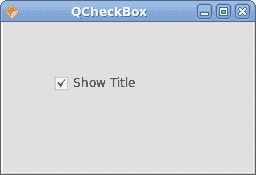
图:QCheckBox
QLabel
QLabel小部件用于显示文本或图像。 没有用户交互。
package com.zetcode;
import com.trolltech.qt.gui.QApplication;
import com.trolltech.qt.gui.QFont;
import com.trolltech.qt.gui.QLabel;
import com.trolltech.qt.gui.QVBoxLayout;
import com.trolltech.qt.gui.QWidget;
/**
* ZetCode QtJambi tutorial
*
* This program uses QLabel to
* show lyrics of a song
*
* @author jan bodnar
* website zetcode.com
* last modified March 2009
*/
public class JambiApp extends QWidget {
public JambiApp() {
setWindowTitle("You know I'm no Good");
initUI();
move(300, 300);
show();
}
private void initUI() {
String text =
"Meet you downstairs in the bar and heard\n" +
"your rolled up sleeves and your skull t-shirt\n" +
"You say why did you do it with him today?\n" +
"and sniff me out like I was Tanqueray\n\n" +
"cause you're my fella, my guy\n" +
"hand me your stella and fly\n" +
"by the time I'm out the door\n" +
"you tear men down like Roger Moore\n\n" +
"I cheated myself\n" +
"like I knew I would\n" +
"I told ya, I was trouble\n" +
"you know that I'm no good";
QLabel label = new QLabel(text, this);
label.setFont(new QFont("Purisa", 9));
QVBoxLayout vbox = new QVBoxLayout();
vbox.addWidget(label);
setLayout(vbox);
}
public static void main(String[] args) {
QApplication.initialize(args);
new JambiApp();
QApplication.exec();
}
}
我们的示例在窗口中显示了歌曲的歌词。
String text =
"Meet you downstairs in the bar and heard\n" +
...
我们定义了多行文字。
QLabel label = new QLabel(text, this);
label.setFont(new QFont("Purisa", 9));
我们创建标签小部件并更改其字体。
QVBoxLayout vbox = new QVBoxLayout();
vbox.addWidget(label);
setLayout(vbox);
代替手动编码标签的位置和大小,我们将标签放入盒子布局中。
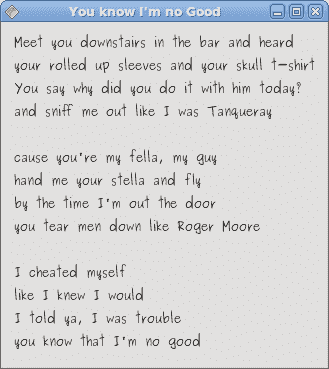
图:QLabel
QLineEdit
QLineEdit是一个小部件,允许输入和编辑单行纯文本。 QLineEdit小部件具有撤消/重做,剪切/粘贴和拖放功能。
package com.zetcode;
import com.trolltech.qt.gui.QApplication;
import com.trolltech.qt.gui.QLabel;
import com.trolltech.qt.gui.QLineEdit;
import com.trolltech.qt.gui.QWidget;
/**
* ZetCode QtJambi tutorial
*
* This program shows text
* which is entered in a QLineEdit
* widget in a QLabel widget
*
* @author jan bodnar
* website zetcode.com
* last modified March 2009
*/
public class JambiApp extends QWidget {
QLabel label;
public JambiApp() {
setWindowTitle("QLineEdit");
initUI();
resize(250, 200);
move(300, 300);
show();
}
private void initUI() {
label = new QLabel(this);
QLineEdit edit = new QLineEdit(this);
edit.textChanged.connect(this, "onChanged(String)");
edit.move(60, 100);
label.move(60, 40);
}
private void onChanged(String text) {
label.setText(text);
label.adjustSize();
}
public static void main(String[] args) {
QApplication.initialize(args);
new JambiApp();
QApplication.exec();
}
}
在我们的示例中,我们显示了两个小部件。 行编辑和标签小部件。 输入到行编辑中的文本显示在标签窗口小部件中。
QLineEdit edit = new QLineEdit(this);
QLineEdit小部件已创建。
edit.textChanged.connect(this, "onChanged(String)");
当我们在行编辑中键入或删除某些文本时,将触发onChanged()方法。
private void onChanged(String text) {
label.setText(text);
label.adjustSize();
}
在onChanged()方法中,我们将行编辑的内容设置为标签窗口小部件。 adjustSize()方法确保所有文本都是可见的。
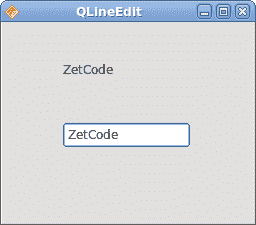
图:QLineEdit小部件
ToggleButton
切换按钮是设置了可检查标志的按钮。 切换按钮是具有两种状态的按钮。 已按下但未按下。 通过单击可以在这两种状态之间切换。 在某些情况下此功能非常合适。
package com.zetcode;
import com.trolltech.qt.gui.QApplication;
import com.trolltech.qt.gui.QColor;
import com.trolltech.qt.gui.QPushButton;
import com.trolltech.qt.gui.QWidget;
import java.util.Formatter;
/**
* ZetCode QtJambi tutorial
*
* This program uses toggle buttons to
* change the background color of
* a widget
*
* @author jan bodnar
* website zetcode.com
* last modified March 2009
*/
public class JambiApp extends QWidget {
private QWidget square;
private QColor color;
private QPushButton redb;
private QPushButton greenb;
private QPushButton blueb;
public JambiApp() {
setWindowTitle("Toggle Buttons");
initUI();
resize(350, 240);
move(300, 300);
show();
}
private void initUI() {
color = new QColor();
redb = new QPushButton("Red", this);
redb.setCheckable(true);
greenb = new QPushButton("Green", this);
greenb.setCheckable(true);
blueb = new QPushButton("Blue", this);
blueb.setCheckable(true);
redb.toggled.connect(this, "onToggled()");
greenb.toggled.connect(this, "onToggled()");
blueb.toggled.connect(this, "onToggled()");
square = new QWidget(this);
square.setStyleSheet("QWidget { background-color: black }");
redb.move(30, 30);
greenb.move(30, 80);
blueb.move(30, 130);
square.setGeometry(150, 25, 150, 150);
}
public void onToggled() {
int red = color.red();
int green = color.green();
int blue = color.blue();
if (redb.isChecked()) {
red = 255;
} else {
red = 0;
}
if (greenb.isChecked()) {
green = 255;
} else {
green = 0;
}
if (blueb.isChecked()) {
blue = 255;
} else {
blue = 0;
}
color = new QColor(red, green, blue);
Formatter fmt = new Formatter();
fmt.format("QWidget { background-color: %s }", color.name());
square.setStyleSheet(fmt.toString());
}
public static void main(String[] args) {
QApplication.initialize(args);
new JambiApp();
QApplication.exec();
}
}
在代码示例中,我们使用三个切换按钮来更改矩形小部件的颜色。
private QWidget square;
private QColor color;
private QPushButton redb;
private QPushButton greenb;
private QPushButton blueb;
我们定义了五个对象。 正方形小部件是QWidget,它显示颜色。 color变量用于保存颜色值。 这三个按钮是切换按钮,用于混合颜色值。
redb = new QPushButton("Red", this);
redb.setCheckable(true);
我们创建一个QPushButton小部件。 setCheckable()方法将按钮更改为切换按钮。
redb.toggled.connect(this, "onToggled()");
greenb.toggled.connect(this, "onToggled()");
blueb.toggled.connect(this, "onToggled()");
所有三个按钮都插入到一个方法调用中,即onToggled()方法。
square = new QWidget(this);
square.setStyleSheet("QWidget { background-color: black }");
我们创建方形小部件。 一开始是黑色的。 在 QtJambi 中,我们使用样式表来自定义小部件的外观。
在onToggled()方法内部,我们确定颜色值并将正方形小部件更新为新颜色。
int red = color.red();
int green = color.green();
int blue = color.blue();
在这里,我们确定方形小部件的当前颜色。
if (redb.isChecked()) {
red = 255;
} else {
red = 0;
}
根据红色切换按钮的状态,更改颜色的红色部分。
color = new QColor(red, green, blue);
我们创建一个新的颜色值。
Formatter fmt = new Formatter();
fmt.format("QWidget { background-color: %s }", color.name());
这两行创建样式表的文本。 我们使用 Java Formatter对象。
square.setStyleSheet(fmt.toString());
正方形的颜色已更新。
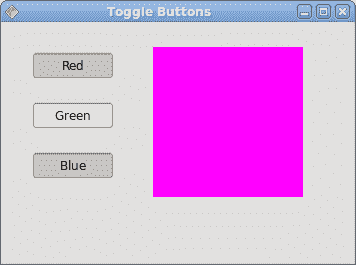
图:开关按钮
QComboBox
QComboBox是一个小部件,允许用户从选项列表中进行选择。 这是一个显示当前项目的选择小部件,可以弹出可选择项目的列表。 组合框可能是可编辑的。 它以占用最少屏幕空间的方式向用户显示选项列表。
package com.zetcode;
import com.trolltech.qt.gui.QApplication;
import com.trolltech.qt.gui.QComboBox;
import com.trolltech.qt.gui.QLabel;
import com.trolltech.qt.gui.QWidget;
/**
* ZetCode QtJambi tutorial
*
* This program uses the QComboBox widget.
* The option selected from the combo box is
* displayed in the label widget.
*
* @author jan bodnar
* website zetcode.com
* last modified March 2009
*/
public class JambiApp extends QWidget {
QLabel label;
public JambiApp() {
setWindowTitle("QComboBox");
initUI();
resize(250, 200);
move(300, 300);
show();
}
private void initUI() {
label = new QLabel("Ubuntu", this);
QComboBox combo = new QComboBox(this);
combo.addItem("Ubuntu");
combo.addItem("Fedora");
combo.addItem("Mandriva");
combo.addItem("Red Hat");
combo.addItem("Mint");
combo.currentStringChanged.connect(this, "OnActivated(String)");
combo.move(50, 30);
label.move(50, 100);
}
private void OnActivated(String text) {
label.setText(text);
label.adjustSize();
}
public static void main(String[] args) {
QApplication.initialize(args);
new JambiApp();
QApplication.exec();
}
}
在我们的代码示例中,我们有两个小部件。 组合框和标签小部件。 从组合框中选择的选项显示在标签中。
label = new QLabel("Ubuntu", this);
这是一个标签,它将显示组合框中当前选择的选项。
QComboBox combo = new QComboBox(this);
我们创建QComboBox小部件的实例。
combo.addItem("Ubuntu");
combo.addItem("Fedora");
combo.addItem("Mandriva");
combo.addItem("Red Hat");
combo.addItem("Mint");
组合框将填充值。
combo.currentStringChanged.connect(this, "OnActivated(String)");
当我们从组合框中选择一个选项时,将触发OnActivated()方法。
private void OnActivated(String text) {
label.setText(text);
label.adjustSize();
}
在OnActivated()方法中,我们将标签小部件更新为从组合框中选择的当前字符串。
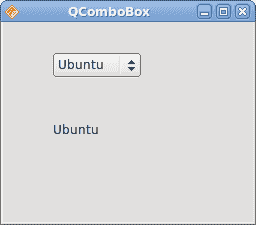
图:QComboBox小部件
在 QtJambi 教程的这一部分中,我们介绍了几个 QtJambi 小部件。

